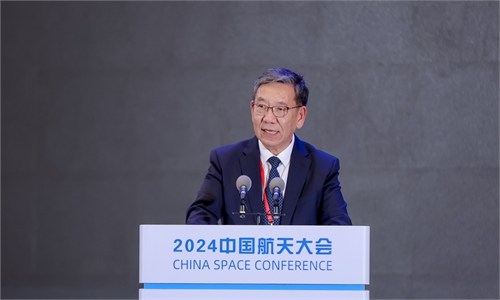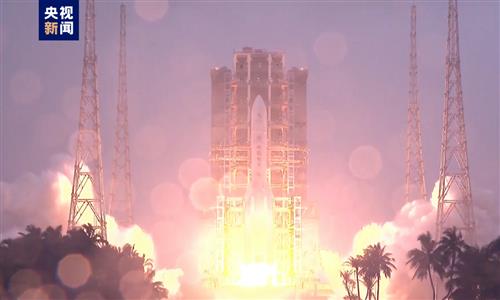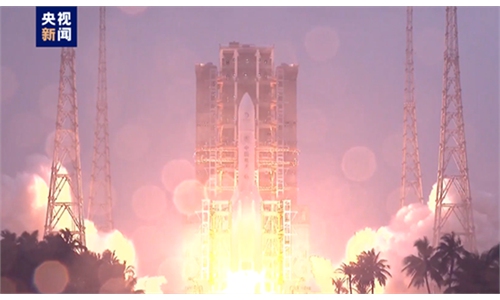More than 70 scientific achievements published on studies of lunar samples brought back by Chang’e-5 probe

Photo shows China's first lunar sample at the opening ceremony on the Space Day of China on April 24, 2021. Photo: Deng Xiaoci/GT
As China's Chang'e-6 probe is about to start scooping and drilling on Earth's natural satellite following a smooth touchdown on the far side of the moon on Sunday, researchers studying the lunar samples brought back by the previous Chang'e-5 mission have accomplished a number of milestone achievements with over 70 findings being published in major academic journals both at home and abroad.
Having discovered that the samples retrieved by Chang'e-5 are "the youngest" lunar samples, Chinese researchers said the Chang'e-6 is expected to dig up older ones, by contrasting the two, may develop a better explanation of lunar evolution.
A total of 1,731 grams of lunar samples were brought back by Chang'e-5 mission in December 2020. These samples were the first ever obtained from a young lunar surface region of volcanic rocks by mankind. They are also the first extraterrestrial celestial bodies' samples brought back to Earth by Chinese scientists, He Huaiyu, a research fellow from the Institute of Geology and Geophysics, Chinese Academy of Sciences, was quoted as saying by China News Service on Sunday.
After evaluation conducted by an expert committee, the China National Space Administration (CNSA) has completed the distribution of six batches of Chang'e-5 lunar samples. A total of 258 proportions of lunar samples weighing 77.7 grams have been distributed to 114 research teams from 40 research institutions, He said.
Despite the fact that the distributed lunar soil samples account for only 4.5 percent of the total, fruitful scientific achievements have been made in multiple fields, including lunar formation, evolution, space weathering processes and mechanisms, and the utilization of resources.
To date, more than 70 research scientific findings have been published in prominent domestic and international academic journals such as Science, Nature, and National Science Review, garnering widespread attention and high praise within the academic circle.
The Chang'e-5 mission collected lunar soil from the Oceanus Procellarum region on the moon's surface. Through the studies, researchers were surprised to discover that the moon is "younger" than previously estimated, having confirmed that that the youngest basalt rock on the moon is 2 billion years old, pushing back the end of lunar volcanic activity by about 800 million years.
"This indicates that the samples retrieved by Chang'e-5 are the youngest lunar samples," said Hu Haode, a research fellow from the CNSA's Lunar Exploration and Space Engineering Center, adding that Chang'e-6 may potentially collect older lunar samples.
This is because the Chang'e-6 landed at the South Pole-Aitken Basin, which is currently the largest known impact crater in the solar system. And this major impact event would likely bring materials from the deep interior of the moon to its surface.
"Comparing ancient lunar soil samples with younger samples holds significant scientific importance and may assist in better understanding lunar evolution and other scientific questions," Hu noted, the Beijing Daily reported.
China's lunar exploration missions have adopted a more open collaborative approach, inviting international partners to participate in payload delivery and scientific research. In contrast, US' lunar exploration plans, such as the Artemis program, focus on returning to the moon, establishing a sustainable human presence and preparing for farther and deeper space exploration missions like Mars exploration, Kang Guohua, a professor of Aerospace Engineering at Nanjing University of Aeronautics and Astronautics, told the Global Times on Monday.
"China is willing to share research results with international partners in lunar exploration missions, whereas the US has maintained more independence in terms of technology and results, including during the previous Apollo program," Kang noted, adding that the successful implementation of the Chang'e-5 and -6 missions not only demonstrates China's technological advancements in space but also provides new opportunities for international space cooperation.
"Currently, all of humanity's lunar sample collection missions have focused on the near side of the moon. Chang'e-6 is set to become the first mission in human history to retrieve samples from the far side, once again filling in the gap in lunar samples. This has significant scientific value in enriching our understanding of the origin and evolution of the satellite, as well as providing better insights into the Earth," said Zuo Wei, the chief designer of the ground application system for the Chang'e-6 mission.
Commenting on Chang'e-6's smooth touchdown, Chinese Foreign Ministry spokesperson Mao Ning said on Monday that the mission marks a historic step in China's outer space exploration and the peaceful use of outer space by humanity.
"China is willing to deepen international cooperation in aerospace exchange on the basis of equality, mutual benefit, peaceful use, and inclusive development, and share the achievements with countries around the world," Mao said.



